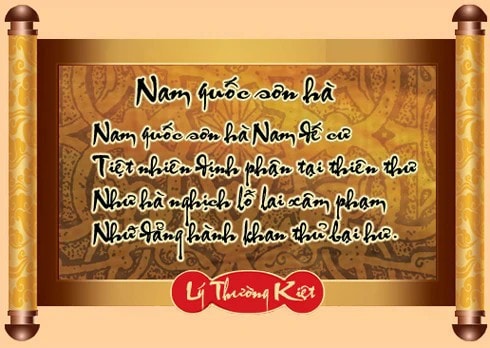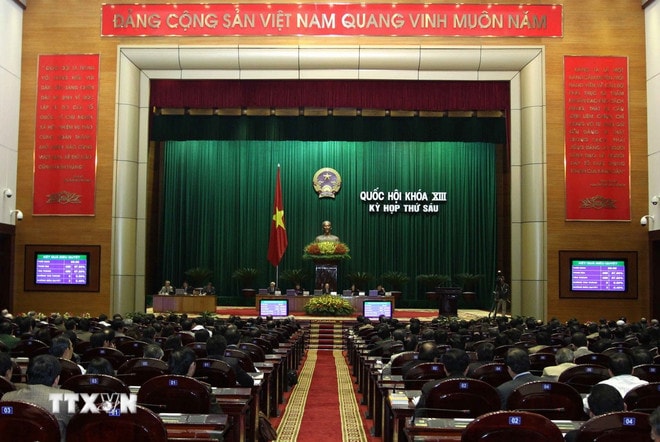On the occasion of Tet At Ty 2025, let's review with Hai Duong electronic newspaper some memorable Ty years in the history of the Vietnamese nation.

March of the lunar calendar, the first resistance war against the Song invaders.
The army and people of Dai Viet, under the leadership of King Le Dai Hanh, defeated the invading Song navy led by Luu Trung at Bach Dang River, beheaded General Hau Nhan Bao at Binh Lo (Soc Son - Hanoi), defeated the enemy at Tay Ket (Ha Bac), chased General Tran Kham To away, captured two generals Trieu Phung Huan and Quach Quan Bien and imprisoned them in the capital Hoa Lu.
The Song Dynasty was so frightened that they had to order a ceasefire. The first resistance against the Song invaders was completely victorious.
The Song Dynasty was determined to take revenge, sending a powerful army led by talented generals Quach Quy and Trieu Tiet to invade our country. The army and people of Dai Viet, under the command of general Ly Thuong Kiet, established a defense line on the Cau River to stop the enemy's advance.
On January 18, 1077, on the Nhu Nguyet River (a section of the Cau River) where our army's defense line was located, the poem "Southern country mountains and rivers" composed by Ly Thuong Kiet:
"The mountains and rivers of the South belong to the Southern Emperor.
Destiny is determined in the book of heaven.
How dare you invade!
You all should be careful of your actions.
Translation:
"The mountains and rivers of the South belong to the Southern king.
Clearly determined fate in the book of heaven
Why did the enemy invade?
You will be beaten to a pulp"
Suffering heavy losses but unable to break through our defense line, the Song army had to accept negotiations with us and withdraw its troops. The second resistance war against the Song invaders by the Dai Viet army and people ended in victory.

Trade with other countries developed. In the second lunar month, merchant ships from three countries: Trao Oa, Lo Lac and Siam entered Hai Dong (Quang Ninh sea area) and asked to stay and trade. King Ly agreed to let them stay on Van Don island and established Van Don port to facilitate trade by sea with merchant ships from other countries.
The first resistance war against the Yuan-Mongol invaders. The Mongol commander in Yunnan, Uryangkhadai, mobilized 30,000 cavalry and infantry troops, along with many talented generals, divided into two groups and followed the Thao River to enter our country.
King Tran Thai Tong led his troops to the North to fight the enemy. After fierce battles, facing the enemy's strength, our troops retreated to preserve their forces. The whole country practiced "empty houses and gardens," conducting guerrilla warfare to wear down the enemy.
On December 24, King Tran counterattacked, defeated the enemy in Dong Bo Dau (Long Bien-Hanoi area) and reclaimed the capital. The Yuan-Mongol invaders had to flee back to their country.
In January, King Le Thanh Tong personally plowed the fields and urged his officials to follow him. This custom was initiated by King Le Dai Hanh nearly 500 years ago, on the occasion of the New Year every year to encourage farmers to plow. In the second lunar month, King Le Thanh Tong ordered a ban on alcohol consumption to limit drunkenness and neglect of work among officials.
In the sixth lunar month, the Le - Trinh court stepped up diplomatic activities to preserve the national territory, sending envoys to the Qing dynasty to demand the return of the districts of Bao Lac, Thuy Vi, Vi Xuyen, and Quynh Nhai.
In the second lunar month, the Tay Son army led by the three brothers Nguyen Nhac, Nguyen Hue and Nguyen Lu captured Ha Dao, Tuy Vien and neighboring areas (present-day Quang Ngai and Binh Dinh).
In the eighth lunar month, the insurgents captured Quy Nhon citadel, and Governor Nguyen Khac Tuyen was frightened and fled. After capturing Quy Nhon citadel, the insurgents continuously attacked the prefectures of Quang Ngai, Dien Khanh, Binh Khang, and Binh Thuan.
The power of the insurgents from here grew stronger and stronger, developing into the large Tay Son peasant movement later with glorious feats of arms to overthrow the corrupt Le - Trinh - Nguyen dynasty, defeating 200,000 Qing troops.
In January, the Phan Ba Vanh uprising broke out with the base at Tra Lu (old Ha Nam Ninh). The insurgents operated throughout the coastal provinces from Quang Yen to Thanh Hoa, contributing to the weakening of the Nguyen Dynasty. In the second lunar month, the Imperial Academy was established in the capital city of Hue.
In the fourth lunar month, historian Phan Huy Chu presented the court with the book "Chronicle of the Dynasties" includes 49 volumes.
On August 30, Trinh Van Can, also known as Doi Can, and Luong Ngoc Quyen led patriotic soldiers in an uprising in Thai Nguyen, destroying prisons, releasing political prisoners, and taking control of the town for 6 days.
In March, the first Communist Party cell in Vietnam consisting of 7 party members: Ngo Gia Tu, Nguyen Duc Canh, Do Ngoc Du, Trinh Dinh Cuu, Tran Van Cung, Duong Hac Dinh, Kin Ton, with comrade Tran Van Cung as cell secretary, was established.
The Vietnam Revolutionary Youth Association - a predecessor organization of the Party - had an active role in promoting the development of the revolutionary movement, but was no longer suitable for the development of the movement.
After the May 1929 Congress of the Association, communist organizations were born in Vietnam: Indochina Communist Party (June 1929); Annam Communist Party (July 1929); Indochina Communist Federation (September 1929), which was the basis for the birth of the Communist Party of Vietnam one year later (February 3, 1930).
On October 25, the Viet Minh Front was born. Under the leadership of the Party, the Viet Minh Front built up mass forces, organized national salvation organizations in both rural and urban areas, and had a system from the central to the grassroots level. Many patriotic organizations joined as members of the Viet Minh Front. All had the same goal: to drive out colonialists and imperialists, and gain freedom and independence for the people.
The Viet Minh Front was an important factor contributing to the victory of the historic August Revolution in 1945, bringing power into the hands of the people.
In November, the 5th Conference of the Party Central Committee unanimously approved the land platform and decided to implement land reform in the liberated areas to realize "land to the tillers", liberating productive forces to strongly develop the economy, fostering people's strength, and promoting the resistance war against the French.
The land reform contributed decisively to the victory of the Winter-Spring 1953-1954 campaign, culminating in the Dien Bien Phu campaign, bringing our nation's resistance war against French colonialism to complete victory.
In 1965 - At Ty, the US imperialists escalated their bombardment of the socialist North. The North shifted to economic construction, fighting the first destructive war by the US air force and navy. The whole country continued the long and arduous but glorious resistance war against the US, ending with the historic victory in 1975, completely liberating the South and unifying the country. The whole country moved towards socialism with the goal of building an independent, democratic, prosperous and civilized Vietnam.
The 9th National Congress of the Communist Party of Vietnam opens the 21st century, promising new heights and new achievements.
The Congress inherits and develops the achievements of previous congresses, promotes the strength of the entire nation, continues innovation, promotes industrialization and modernization, develops a knowledge-based economy to promote internal strength and strengthen integration, build and firmly protect the socialist Vietnamese Fatherland.

At the 5th and 6th sessions, the 13th National Assembly passed the amended 1992 Constitution, the amended Land Law and many other important laws; decided on socio-economic tasks for the remaining period of the 5-year Plan (2011-2015); and strengthened supreme supervision by organizing the first vote of confidence for those holding positions elected or approved by the National Assembly. These events are of special significance to the country's development, meeting the expectations of voters and people nationwide.
VN (according to VNA)